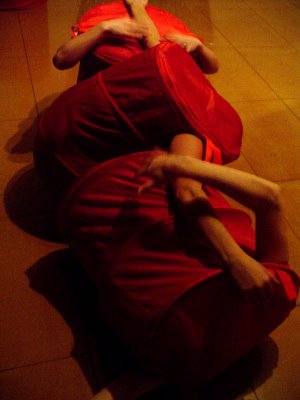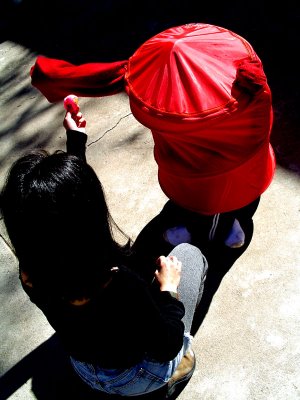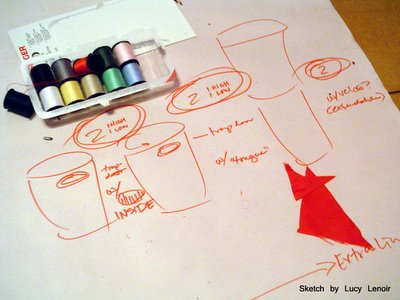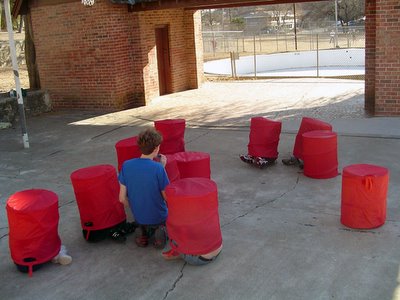
R. Beegle
Notes & Observations:
RED CANS – FINAL WEEKEND
January 28-29, 2006
SATURDAY.
Instead of at public park, rehearsal has been moved to Josh and Matt’s apartment, due to rain. Slick laminate floor. All furniture has been pushed into the hallway or leaned up again the wall. Inside here, it is private and dark and humid: is this a more likely ‘can’ environment, than the sunny sociable park?
Sliding for the cans, mobility, is easier on slick laminate than on the crumbling concrete of the old basketball court at the park.
During 15 minutes of “open canning” the cans are given flashlights.
Is it warm and comfortable in here, or is it stifling?
One of the modified cans, with the sacks attached, is called Stomach Can. One of the actor’s arm came out of the hole in Stomach Can, the other hung limply in the lose red terrycloth sack – does this sack represent a severed limb, a memory of dismemberment? A phantom limb? Or, are we catching these beings in mid-evolution? Will the sack, as we watch, become useful? Or is it already being discarded, a failed genetic experiment, that will disappear completely in a few more generations? The cans seem at a formative stage, mid-evolution. The loose sacks are appendages that are no longer needed, that are disappearing -- or maybe they are growing into something: in a few generations, that sack will be more like an arm.
Which is it? Is the sack growing useless, or growing useful? Which direction are we moving, evolutionarily speaking? Are we watching progress or deterioration?
Flashlights are used both within cans, and outside of cans (poking out through holes) to point toward each other and at audience. Flashlights with visible actor arm attached versus flashlight just sticking out of a hole in the can. One could argue that it is more interesting if flashlight itself is never seen. The light inside the can is more interesting. And instead of better illumining the human inside, the flickering lights make the actors’ body shapes more abstract, less identifiable.
There is music for this period of open canning – atmospheric and spacey. Feels like a moonwalk or an alien exploration. As the music subsides, someone starts beating from within a can, hitting the nylon from the inside, and then the others join in like a protest, or a demand for something.
When the flashlight has a focused beam, coming from inside a can, it is like an iris or retina, a cycloptic searching eyeball. When it moves about, it appears to be frantically searching for something.
Are these cans fossils from our collective memories? Our future? Our prehistorical past?
Seriously today’s rehearsal is a little spooky. Like we all might at any moment change states from solid to liquid.
The Stomach Can “reaches out” to other cans with its appendages– is this a positive development, or a regressive trait? Is this a biological reflex, a learned behavior, or a bad habit it is trying to quit?
When the flashlight beams seem like little heartlights – when they flicker or flip off and on, they seem like some kind of beating organ – are these cans robots or tadpoles?
Are the flashlight beams investigative organs, like antennas?
Are differences among cans (head bumps, appendages, etc.) birth defects or evolutionary leaps?
There is a creepy, fast, manic shuddering within certain cans, with a flickering flashlight beam, which is weird and unsettling in this dark and dank environment.
This private, swampy and cavernous rehearsal space and the atmospheric music are so very different from the public park environment. Whole different feeling: not so delightful, instead it’s more alarming and darkly amusing.
Stomach can falls on its side but the loose sack becomes suddenly turgid, and sticks straight up into the air – rigor mortis? A sign of something? Is this the end? Does the can animal procreate as it’s dying?
As the music stopped, the cans filled the void by making sounds, various comical bodily noises.
Elizabeth suggests a possible climax to the performance: Use flashlights plus a weird lighting effect to reveal what’s inside the can, show the actor’s faces, a final reveal.
Does the production need “can shepherds” to herd the cans to the correct places, and to make sure they don’t get hurt? Or maybe a pole or hook or a crane, some outside force, could wrangle the cans. Some machine’s arm.
Are the cans cultish? Are they headed toward mass suicide, like lemmings? Are they a failed design, one that is about to self-destruct? Maybe that’s the climax: the failed cans self-destruct, in all manner of arresting ways.
Josh: maybe there will be a ‘mock’ can onstage, that will be crushed flat by a heavy object dropped from above. The audience thinks there was an actor inside…
The actors might wear costumes of total red, head-to-toe red, like inside a snail’s shell, and they may leave a slug’s trail.
How to achieve mass liquid spurting forth from a can?
Cole’s idea for this rehearsal: Cans act out stories from the Bible, just announce a title (“David and Goliath”) and then the cans go about representing the story.
SUNDAY:
During open canning, Rosaruby asks to be zipped completely into one of the modified cans – complete sheathed and zipped, at both top and bottom, tightly into the short nylon cylinder sack, with a flashlight inside. Inside the can with her flickering flashlight, she lies on what may be her back and begins to shudder – fast, rhythmic, and seeming to reach some kind of culmination. A masturbating sack? Do cans reproduce alone, by budding? Then, suddenly, she thrusts both arms out of the small holes at the top of the can. Her arms are exactly as long as the height of the can, and seem very masculine and even a little frightening. So very strange. A little bit Todd Browning’s “Freaks,” the “one of us, one of us” mantra. She lifts herself (still completely incased, zipped into, the short nylon can) with her arms and moves about the room on her hands in a muscular fashion, blindly grabbing ahold of everything in her path. These muscular, moving and searching arms and yet no head, no other defining feature. These arms make the cans seem even less human, more bizarre. Like something born without a face or a conscience. A bully with no brain.
At one point she places the flashlight down at the bottom front of the can, and with her arms out, and the beam of light shining forth from her crotch, it’s as though she’s presenting biology in its most basic state: a lighted tip, moving unthinkingly toward you.
But then, the flashlight can be removed, and moved to other areas of body. In how many ways are these cans differently abled?
The flashlights beaming on and off within separate cans seems to beat like a semaphore between cans, a way to communicate. Also, seems like other cans are peeking at what their peers are up to. (Even though in actuality, it is still difficult for the actors to see what’s going on within the other cans.)
Rosaruby lies on her back in her can, flashlight beam facing out at us. Her lifted and curved legs within the can create a frame for a small diorama: she makes finger puppets in the shape of a beating heart, and then she actually beats the bottom of her can, the sound of heartbeats on the nylon membrane, an impenetrable membrane? This can seems very separate from others and alone, stuck inside can but still trying to communicate.
What if we hear true sounds of distress from within a can, like the sounds of an actor who wants to be let out of the can, but no one comes to let them out? Is it part of the play, or is it the real sound of an actor’s distress?
Rosaruby’s hands slapping the laminate floor – this is a good sound.
What if the cans with arms and hands out attempt to assume classical Greek poses?
Are the cans prehistoric or more fully developed than current humans or are they robots?
Should an unrelated body suddenly enter the performance? A giant cowboy piñata? Someone dressed as a piñata? A child? A child in costume? Reminded of Pierre Huyghe film
“Streamside Day” part of which features a parade in which children are dressed in strange slapdash half-animal costumes, slightly degraded, and someone is dressed as a menacing collection of moving boxes. Seems to go along with this question of: where are we, in the history of evolution, and in which direction are we moving?
http://www.imma.ie/en/page_72393.htm
When multiple cans have their arms thrust out, the cans can link arms in interesting ways. More like a mollusk, can extend or retract parts of its body in and out of its shell. Actually, it’s a little sickening. But in a good way.





